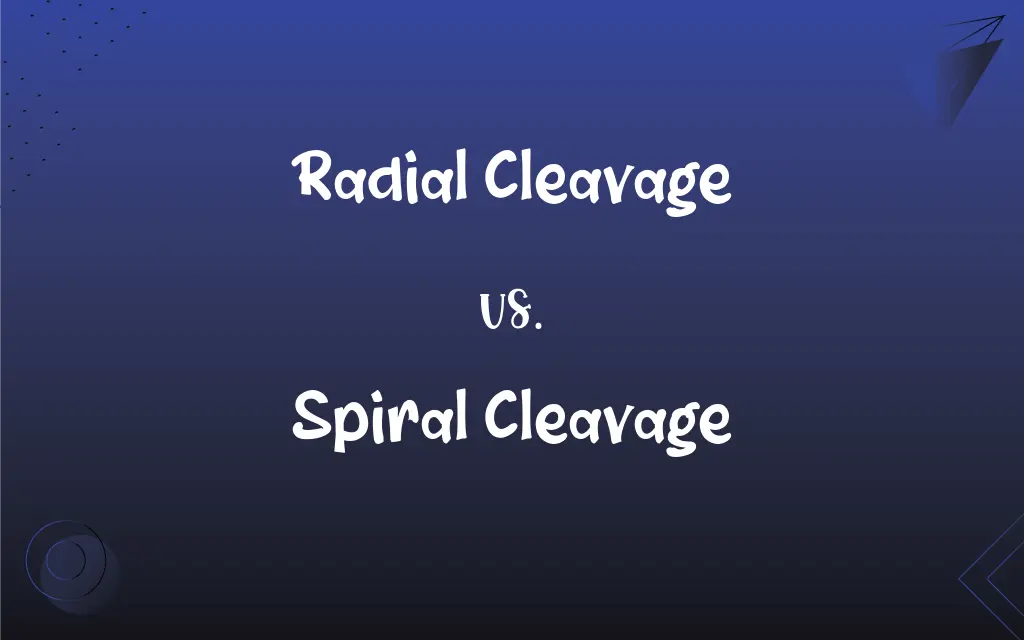Radial Cleavage vs. Spiral Cleavage: What's the Difference?
Edited by Aimie Carlson || By Janet White || Published on February 15, 2024
Radial cleavage involves embryonic cell divisions aligned perpendicularly or parallel, typical in deuterostomes, while spiral cleavage has cells dividing in oblique angles, common in protostomes.

Key Differences
Radial cleavage is a characteristic of deuterostomes, where the divisions of the embryo's cells occur either parallel or perpendicular to the axis of the embryo. This results in the layers of cells being aligned directly above each other. In contrast, spiral cleavage, typical of protostomes, involves cells dividing at oblique angles relative to the axis, creating a spiral-like pattern of cells.
In radial cleavage, the cells are arranged in a radial symmetry, meaning any plane through the center divides the embryo into mirror images. This type of cleavage leads to a predictable and consistent cell lineage. Spiral cleavage, however, produces a more complex arrangement where the cells are offset, and each division results in cells that lie in the grooves between cells of the previous layer.
The development potential of cells in radial cleavage is often considered regulative. In this type, the fate of each cell isn't determined early; cells can adapt to form different structures if separated. In spiral cleavage, the cells exhibit determinate development, where the fate of each cell is more rigidly set early in development.
Radial cleavage is seen in animals like echinoderms (starfish, sea urchins) and chordates (including vertebrates). This pattern supports the development of a more complex body plan. Spiral cleavage is observed in annelids (segmented worms), mollusks, and other invertebrates, playing a role in the diverse body structures seen in these groups.
The cleavage pattern affects gastrulation, the process forming the embryonic layers. In radial cleavage, the process involves invagination or folding of cell layers. In spiral cleavage, gastrulation is more complex, involving movements like epiboly, where cells spread as a thin layer over other cells.
ADVERTISEMENT
Comparison Chart
Cell Alignment
Cells align perpendicularly or parallel.
Cells divide at oblique angles.
Symmetry
Radial symmetry in arrangement.
Spiral, offset arrangement of cells.
Developmental Potential
Regulative (cells can adapt roles).
Determinate (cell fate set early).
Examples of Organisms
Echinoderms, chordates (vertebrates).
Annelids, mollusks.
Gastrulation Process
Invagination or folding of cell layers.
Complex movements like epiboly.
ADVERTISEMENT
Radial Cleavage and Spiral Cleavage Definitions
Radial Cleavage
Radial cleavage is a cell division pattern where cells align radially during embryonic development.
In sea urchins, radial cleavage ensures the cells divide perpendicular or parallel to the axis.
Spiral Cleavage
Spiral cleavage is characteristic of protostomes, where cells divide at oblique angles.
Annelids exhibit spiral cleavage, contributing to their unique body structure.
Radial Cleavage
Radial cleavage results in embryonic cells stacked directly above each other.
The radial cleavage in vertebrates leads to a structured, predictable cell arrangement.
Spiral Cleavage
Spiral cleavage is a type of embryonic cell division where cells are arranged in a spiral pattern.
In snails, the spiral cleavage creates a distinct offset pattern in the embryo's cells.
Radial Cleavage
Radial cleavage is characteristic of deuterostomes, with regulative development potential.
Due to radial cleavage, if some cells of a sea urchin embryo are removed, the remaining can still form a complete organism.
Spiral Cleavage
Spiral cleavage leads to determinate development, setting cell fates early.
Due to spiral cleavage in mollusks, each cell's role in the embryo is predetermined early on.
Radial Cleavage
Radial cleavage allows embryonic cells to have flexible developmental fates.
The regulative nature of radial cleavage in echinoderms allows for adaptability in early development.
Spiral Cleavage
Spiral cleavage affects gastrulation with movements like epiboly.
The gastrulation process in organisms with spiral cleavage is more intricate due to the spiral arrangement of cells.
Radial Cleavage
Radial cleavage involves cells dividing in a way that preserves radial symmetry.
Radial cleavage in chordates facilitates the formation of mirror images on either side of their body axis.
Spiral Cleavage
Spiral cleavage involves complex cell arrangements unlike the radial symmetry in deuterostomes.
The offset cell layers in spiral cleavage create a more complex embryonic structure than radial cleavage.
FAQs
How does radial cleavage affect embryonic development?
It allows regulative development, where cell roles can adapt.
What is spiral cleavage?
Spiral cleavage is a pattern of embryonic cell division where cells are arranged in a spiral.
What is radial cleavage?
Radial cleavage is a pattern of embryonic cell division characterized by perpendicular or parallel alignment.
What types of organisms show spiral cleavage?
Spiral cleavage is typical in protostomes like annelids and mollusks.
Which organisms exhibit radial cleavage?
Radial cleavage is found in deuterostomes like echinoderms and chordates.
Does spiral cleavage contribute to organism complexity?
Yes, it contributes to complex body structures in protostomes.
Are cells in radial cleavage symmetrically arranged?
Yes, cells in radial cleavage are symmetrically arranged.
Are protostomes the only group with spiral cleavage?
Primarily, though there can be exceptions.
Does spiral cleavage limit cell developmental potential?
Yes, it usually determines cell fate early.
How does radial cleavage relate to an organism's regenerative abilities?
Its regulative nature can contribute to better regenerative capabilities.
Is spiral cleavage determinate or regulative?
Spiral cleavage is determinate, setting cell fates early.
Can radial cleavage lead to identical twins?
Yes, due to its regulative nature, radial cleavage can potentially lead to identical twins.
Can the type of cleavage affect an organism's overall body plan?
Yes, the cleavage pattern can influence the organism's body plan and symmetry.
Can environmental factors affect cleavage patterns?
Generally, cleavage patterns are genetically determined and not heavily influenced by the environment.
What role does radial cleavage play in gastrulation?
Radial cleavage facilitates simpler gastrulation processes like invagination.
How does spiral cleavage affect gastrulation?
It leads to more complex gastrulation movements like epiboly.
Is radial cleavage exclusive to certain animal phyla?
Yes, it's exclusive to deuterostomes.
How does radial cleavage impact embryonic cell potential?
It allows cells to have flexible developmental roles.
Are there evolutionary implications of radial versus spiral cleavage?
Yes, these cleavage patterns reflect different evolutionary paths in animal development.
What is the symmetry like in spiral cleavage?
Spiral cleavage results in asymmetric, spiral cell arrangements.
About Author
Written by
Janet WhiteJanet White has been an esteemed writer and blogger for Difference Wiki. Holding a Master's degree in Science and Medical Journalism from the prestigious Boston University, she has consistently demonstrated her expertise and passion for her field. When she's not immersed in her work, Janet relishes her time exercising, delving into a good book, and cherishing moments with friends and family.
Edited by
Aimie CarlsonAimie Carlson, holding a master's degree in English literature, is a fervent English language enthusiast. She lends her writing talents to Difference Wiki, a prominent website that specializes in comparisons, offering readers insightful analyses that both captivate and inform.































































